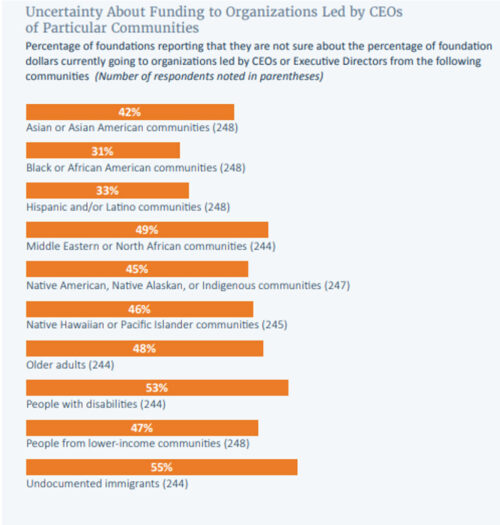In its recently released report, Foundations Respond to Crisis: Lasting Change?, the Center for Effective Philanthropy (CEP) shared new research in which foundations reported working differently now than in early 2020 — and indicated plans to sustain most of these changes. The report reveals numerous areas of change in foundation practice and in leaders’ plans for the future, as well as some disconnects, barriers, and additional opportunities for further change. This is the third in a series of blog posts in which members of CEP’s research team share further data and insights that the research revealed, beyond what was included in the report. Find other posts in this series here.
Most foundation leaders say they are making racial equity a more explicit consideration in how they conduct their work. That’s one of the key findings from CEP’s recently released report, Foundations Respond to Crisis: Lasting Change?. As examples of how they say they are changing their practices, foundation leaders reported that they are increasingly prioritizing communities most affected by systemic inequities, changing how they identify applicants, providing more funding to organizations supporting Black and Latino communities, and listening more to grantees and communities.
Importantly, foundation leaders themselves were quick to acknowledge they still have a lot of work to do.
One area where foundation leaders have their work cut out for them is rigorously collecting and using demographic data about their boards, staffs, donors, applicants, and grantees.
Demographic data collection is crucial for understanding the impact of philanthropic resources and for assessing the extent to which philanthropic resources are advancing equity. As our colleagues at PEAK grantmaking noted in their hot-off-the press suite of resources, Driving Equity With Demographic Data Collection:
“While many funders are exploring demographics to substantiate their claims with respect to advancing equity, others are recognizing what social, political, and biological scientists have known for decades: demographics matter for impact. The more funders know about who is — and who is not — reached by their initiatives, the more insight funders have about intentional and unintentional impacts.”
Yet, most foundation leaders in our recent study said that their foundation does not currently collect demographic data from grantees, and, relatedly, just over half say that they do not have an approach for determining whether an organization is led by the people from the community it serves. Among those that do have an approach for determining whether an organization is led by people from the community, leaders report considering identity markers from the CEO and the board and, to a slightly lesser degree, senior staff.
This lack of data can translate into uncertainty on the part of foundation leaders about how — and to whom — their grant dollars are being allocated. In their funding practices, for example, a sizeable proportion of foundation leaders reported that they are unsure about the percentage of grant dollars going to organizations led by CEOs of various races and demographic characteristics. Check out the below chart for more detail.

This uncertainty is not limited to the racial identities of nonprofit leaders. A good number of foundation leaders were also unsure about the percentage of their grant dollars going to organizations that serve particular communities. Turning to CEP’s recent Overlooked reports, almost 30 percent were not sure about the percentage of their funding that served Native communities, and a similar proportion were not sure about their funding to organizations that serve Asian American and Pacific Islander communities. As one Native American nonprofit leader lamented on the underrepresentation of Native populations in data collection practices, “we are at the bottom of nearly every socioeconomic indicator, but we’re invisible.” (Shireen Zaman & Chris Cardona from Ford Foundation reflected on this very threat of invisibility in their recent post on the CEP blog.)
Despite these clear opportunities for better funder practice, there is some room for cautious optimism. About 40 percent of interviewed foundation leaders said that, since the beginning of 2020, they have begun or are increasingly focused on demographic data collection, suggesting some momentum towards better demographic data collection practices. As one leader said,
Prior to the murders of George Floyd and Ahmaud Arbery, it felt like we were overstepping when we asked organizations about their board, staff, and who they are serving. It didn’t feel like it was our place to ask. But now it is our place to ask, and we are asking organizations for more information about the racial, ethnic, and gender breakdowns of their staff and board.
So, for the foundation staff and board members who know they can do better, or who are already trying to do better — much like the surveyed foundation leader who said, “We would love guidance on how to do this well,” — below is a non-exhaustive list of resources about demographic data collection, including some tangible funder examples.
Given the importance of good demographic data collection practices for effective funder practice, we hope that these resources help funders better collect and use demographic data.
PEAK Grantmaking:
Driving Equity With Demographic Data Collection, which includes an action planner and four how-to guides:
- Action Planner | Driving Equity With Demographic Data
- How-To Guide | Understand the Power of Equitable Data Collection
- How-To Guide | Decide on a Demographic Data Taxonomy
- How-To Guide | Navigate the Legal and Privacy Landscape Surrounding Demographic Data
- How-To Guide | Communicate Effectively About Your Demographic Data
Supporting Native communities with demographic data, Q&A with Carly Bad Heart Bull
Insight, Impact, and Equity: Collecting Demographic Data
Candid:
Guide for Collecting Demographic Data
The Importance of Talking About — and Collecting Data on — Race to Improve Racial Equity, a CEP blog post by Cathleen Clerkin, senior director of research at Candid
AAPIP: A collection of resources from AAPIP on data disaggregation
CEP: CEP’s Assessment and Advisory team can assist with demographic data collection and analysis efforts. More here in our colleague Kevin’s recent blog post
Funder Examples:
- David & Lucile Packard Foundation
- Ford Foundation
- The Robert Wood Johnson Foundation
- The William and Flora Hewlett Foundation
(P.S. If we’ve missed a great resource about demographic data collection that we should add to this list, we’d love to hear from you!)
Katarina Malmgren is senior analyst, research at CEP. Naomi Orensten is director, research at CEP.


